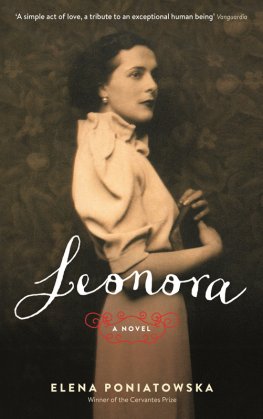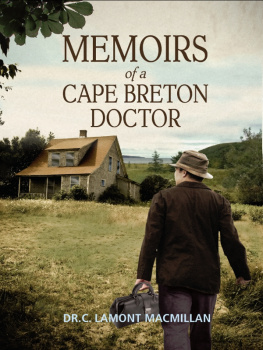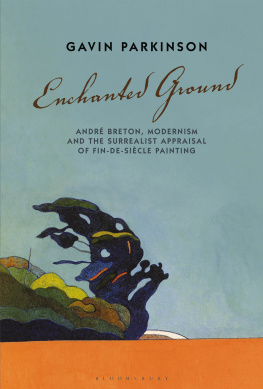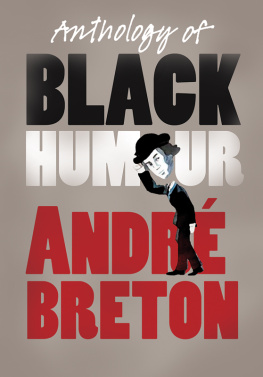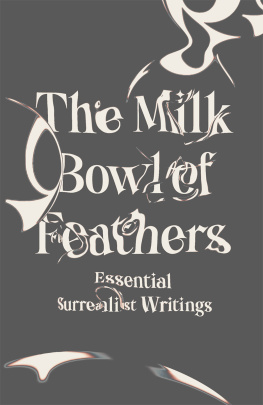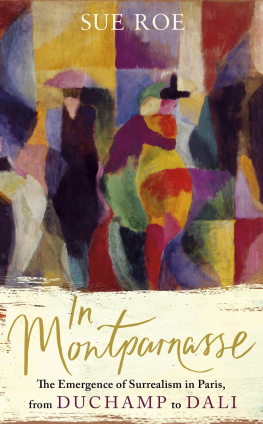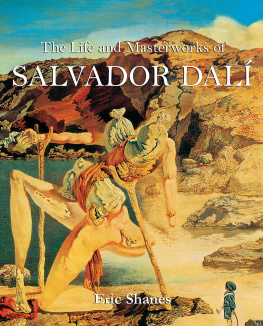ACKNOWLEDGMENTS
IN PREPARING THIS BOOK, I have benefited first and foremost from special access to Bretons unpublished papers and correspondence. This access was granted by Bretons heirs, who waived a specific testamentary provision that the papers not be made public until 2016. Although this provision has now been superseded by the terms of the April 2003 auction of Bretons papers, I remain indebted to Bretons daughter, Aube Ellout, as well as to two key figures who have passed away since this book was first publishedBretons widow, Elisa Breton, and his literary executor, Jean Schusterfor having allowed me to consult these documents at a time when very few people could have access to them.
I am also grateful to Franois Chapon and his assistants at the Bibliothque Littraire Jacques Doucet in Paris; to Claire Blanchon and Brigitte Vincens of the Centre Georges Pompidou; to the staffs of the Harry Ransom Humanities Research Center at the University of Texas, Austin, the Bibliothque Nationale in Paris, the Museum of Modern Art Library and the Archives of American Art in New York, and the Houghton Library at Harvard University; and to Jean-Pierre Dauphin of Editions Gallimard and his able assistant, Liliane Phan, for facilitating my archival research and for putting many documents at my disposal.
Harvard University, New York University, and the French Library in Boston gave me opportunities to test out early versions of some of my material on live audiences. The Cultural Services of the French Ministry of Foreign Affairs financed several indispensable research trips to Paris. More generally, the National Endowment for the Humanities and the Atlantic Center for the Arts provided money and workspace during different segments of the writing process. My thanks to them all.
A number of individuals, some of them now gone, gave generously of their time, memories, insights, collections, and copyright permissions. For want of being able to detail specific contributions, I express my sincere gratitude to Lionel Abel, Hester Albach, Nol Arnaud, Timothy Baum, Jean-Louis Bdouin, Georges Bernier, Jean-Claude Blachre, Michel Carassou, Leonora Carrington, Claude Courtot. Alexina Duchamp, Alain Dugrand, Ccile Eluard, Serge Fauchereau, Monique Fong, Charles Henri Ford, Jacques Fraenkel, Michel Fraenkel, Catherine Gide-Desvignes, Madeleine Goisot, Mary Jayne Gold, Jean-Michel Goutier, Myrtille Hugnet, Edouard and Simone Jaguer, Marcel Jean, Ted Joans, Alain Jouffroy, Nelly Kaplan, Jacqueline Lamba, Michel Leiris, Claude Lvi-Strauss, Helena Lewis, James Lord, Thomas Maeder, Judith Young Mallin, Samir Mansour, Anne de Margerie, Marcel Marin, Julie Martin, Jean-Claude Masson, Pierre Matisse, Yvonne Mayoux, Bernard Minoret, Bernard Morlino, Pierre Naville, Grard Paresys, Andr Parinaud, Henri Pastoureau, Jacqueline Paulhan, Jos Pierre, Jean-Marie Queneau, Dominique Rabourdin, Mme. Georges Ribemont-Dessaignes, Edouard Roditi, Michel Sanouillet, Sylvie, Marc, and Vincent Sator, Meyer Schapiro, Georges Schehad, Georges Sebbag, Georges Seligmann, Philippe Soupault, Matthew Spender, Dorothea Tanning, Paule Thvenin, Andr Thirion, Virgil Thomson, Olivier Todd, Lucien Treillard, Christophe Tzara, and Klaus Wust.
Many others furnished me with books, encouragement, suggestions, criticism, and homes away from home during my years of research and writing. For this and more, my heartfelt thanks go to Pierre Assouline, Neil Baldwin, Susan Bell, Gabriel Bernal Granados, Frdric Berthet, Hector Bianciotti, Marguerite Bonnet, Dominique Bourgois, Jean-Jacques Brochier, Andreas Brown, Marie-Claude de Bruhnoff, Phyllida Burlin -game, Marie Chaix, Isabelle Chtelet, Jacqueline Chnieux-Gendron, Olivier Cohen, the Daynard family, Paul De Angelis for setting the idea in motion, Florence Delay, Jean Echenoz, Didier Eribon, Merceds Fort, Franoise Fritschy, Jean Gaudon for the initial impetus, Elisabeth Gille, Andr Heinrich, Robert Hemenway, Frederick Karl, Aline Luque, Mathieu Marcenac, Robert Massie, Harry Mathews, Roberto Matta, Claude and Ivan Nabokov, Monique Nemers, Pascal Quignard, Zack Rogow, Franois and Annie Samuelson, Enrico Sant, Christopher Sawyer-Lauanno, Rick Scarola, Bob and Franoise Schneider, Jean-Franois Sen, Roger Shattuck, Jacques Simonelli, Sally Singer, Rachel Stella, Dorothy Straight, Susan Suleiman, Denise Tual, Juan Jos Utrilla, Mike Vahala, Trevor Winkfield, Bill Zavatsky, and my parents, Grace and Mario Polizzotti.
Finally, I gratefully acknowledge the help of Deborah Karl and of the publishers and editors in several countries whose advice and guidance have helped make this a much better work than it would otherwise have been: at Farrar, Straus and Giroux, Jonathan Galassi and Paul Elie; at Bloomsbury, Liz Calder; at Carl Hanser Verlag, Michael Kruger; at Editions Gallimard, Eric Vigne, Isabelle Gallimard, and Georges Libert; at Fondo de Cultura Economica, Juan Carlos Rodrguez Aguilar, Joaquin Dez-Canedo Flores, Adolfo Castan, and Laura Gonzlez Durn. And particular thanks to Joe Phillips of Black Widow Press for giving it a new life.
This book is for my wife, Sadi Ranson-Polizzotti, and for my son, Alex Polizzotti.
( 1 )
THE PASSABLY HAGGARD AND VERY HOUNDED CHILD
(February 1896 August 1913)
HE HAD TWO BIRTH DATES. The chronological one, the one that appears on his birth certificate and other official documents, is February 19, 1896. The other, which he permanently adopted in 1934 (and which many of his commentators have perpetuated), is February 18 of the same year. The discrepancy is slight, but as with many aspects of Bretons biography, its importance has been magnified beyond normal proportions.
What lies behind so subtle a change? An attempt to cover biographical tracks? To correct existing data into something more compatible with a desired persona? Possibly both. Throughout his life Breton was extremely parsimonious with personal reminiscences, notably about his childhood; and if his writings are heavilyone might even say shamelesslyautobiographical, the incidents recounted are like so many case studies, at once open to clinical scrutiny and unyielding of much concrete information. Like good sleight of hand, they give the illusion of disclosure without the attendant intimacy.
In addition to this, Breton often evinced a will to improve upon the mundane aspects of existence, to recast them into something larger and more resonanteven if, at times, it meant adjusting his curriculum vitae. He claimed that he had no use for the empty moments of his life, the instances of depression or weakness that would nonetheless visit him so regularly, preferring instead to accentuate the unusual or dramatic episodes, to project them beyond simple biography into something approaching universal truth.
Initially, Bretons change of birth date might have been inspired by his first love, a cousin on his mothers side named Manon, whom he later credited with initiating him into the disturbing blend of seduction and fear that is sexuality. Manon was born on February 18, 1898, and it was not long after their brief liaison that Breton first officially gave his own birth date as February 18, on a medical school registration. But the definitive modification of the 1930s seems to have been governed by a more enduring passion: astrology. Breton had developed a strong interest in astrology in the mid-1920s, seeing the discipline as another way to mine the hidden side of life for the thrilling coincidences it might reveal. In his own case, an astrological reading of February 18 (as opposed to the 19th) establishes various links between himself and several of his most admired predecessors, notably the poets Arthur Rimbaud and Grard de Nerval and the utopian philosopher Charles Fourier. In opting for the 18th, Breton was placing himself from the outset in privileged company, the kind that he would seek throughout his life.


